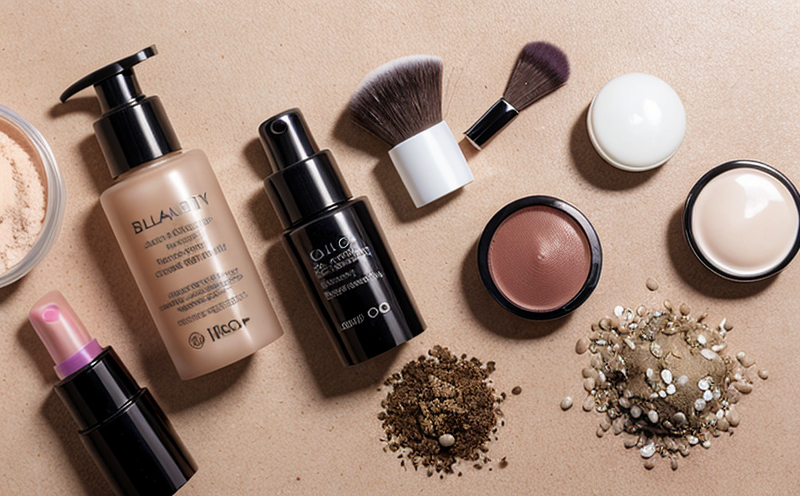OECD 308 Sediment Degradation Testing for Cosmetic Products
The OECD 308 sediment degradation test is a critical analytical procedure used to assess the environmental impact and biodegradability of cosmetic products in aquatic environments. This service plays an integral role in ensuring that cosmetics are environmentally friendly, particularly when they contain organic compounds that may release into natural water bodies during use or disposal.
The OECD 308 test evaluates whether a substance will degrade under conditions similar to those found in sediments at the bottom of freshwater and marine environments. This degradation process is assessed by measuring changes in the chemical composition over time, which helps determine if the product can be safely disposed of without causing harm to aquatic ecosystems.
The significance of this test lies not only in its regulatory compliance but also in its contribution towards sustainable development goals. By ensuring that our clients' products meet stringent environmental standards, we help them demonstrate their commitment to reducing waste and promoting cleaner environments.
Our team of experts uses state-of-the-art facilities equipped with advanced analytical instruments such as high-performance liquid chromatography (HPLC) and gas chromatography-mass spectrometry (GC-MS). These tools enable precise quantification of degradation products, providing reliable data that supports informed decision-making regarding formulation adjustments or process improvements.
It is important to note that while this test focuses primarily on sedimentary environments, its principles extend beyond just cosmetics into other industries dealing with water-soluble chemicals. Understanding how these substances behave in sediments provides valuable insights into their overall environmental behavior across various ecosystems.
In conclusion, OECD 308 sediment degradation testing is essential for any company involved in the development or manufacturing of cosmetic products that aim to minimize their ecological footprint. It offers a robust framework for evaluating potential risks associated with product release into aquatic systems and guides towards creating more sustainable formulations.
Scope and Methodology
| Step | Action |
|---|---|
| 1 | Select appropriate sediment samples from various sources, ensuring they represent typical conditions encountered in aquatic environments. |
| 2 | Mix the selected sediments with test substance solutions at specified concentrations under controlled temperature and light conditions. |
| 3 | Incubate the mixture for a predetermined period, monitoring changes in chemical composition through periodic sampling. |
| 4 | Analyze samples using advanced analytical techniques like HPLC or GC-MS to quantify degradation products and assess overall stability of the test substance. |
| 5 | Determine biodegradation efficiency based on reduction in initial concentration and formation of known metabolites characteristic of biodegradation processes. |
| 6 | Evaluate results against established criteria to classify the test substance according to its potential environmental impact. |
This comprehensive approach ensures accurate assessment of cosmetic products' environmental compatibility, aligning with international standards such as OECD guidelines. The methodology described here provides a structured yet flexible framework that can be adapted based on specific client needs and project requirements.
Eurolab Advantages
- Experienced Professionals: Our team comprises highly skilled chemists, toxicologists, and environmental scientists who are well-versed in conducting OECD 308 tests. They bring extensive experience from diverse industries, ensuring accurate interpretation of results.
- State-of-the-Art Facilities: Equipped with cutting-edge laboratory equipment, including automated sample preparation systems and sophisticated analytical instruments, we provide precise measurements and robust data analysis.
- Comprehensive Reporting: We offer detailed reports tailored to meet your specific requirements, providing clear interpretations of the test outcomes along with recommendations for improvement where necessary.
- Regulatory Compliance: Ensuring compliance with relevant regulations is at the forefront of our services. Our rigorous quality control processes and adherence to international standards guarantee that all tests adhere strictly to applicable guidelines.
By leveraging these advantages, Eurolab ensures that every client receives reliable, accurate, and actionable insights from their OECD 308 sediment degradation testing.
Environmental and Sustainability Contributions
- Reduction of Waste: By identifying potentially harmful components within cosmetic products early in the development process, we contribute to minimizing waste generation throughout production cycles.
- Promotion of Cleaner Water Bodies: Ensuring that our clients' products do not contribute to pollution helps maintain cleaner water bodies and supports healthier aquatic ecosystems.
The OECD 308 sediment degradation test is just one component of a broader strategy aimed at fostering sustainable practices within the cosmetic industry. Through rigorous evaluation and continuous improvement, we aim to drive positive changes that benefit both people and planet.





